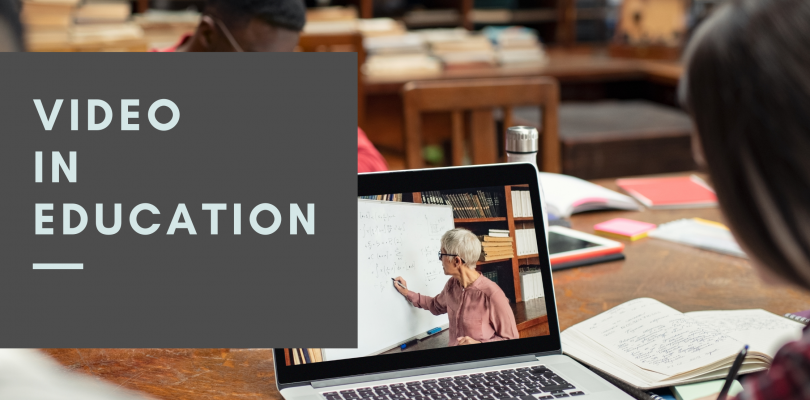Video has become an integral part of our everyday culture. Owing to their widespread influence, they have now extended to education. Students today are using videos as an eLearning tool to learn everything from engineering to arts, finance to medicine, and more.
The concept of video in education has dramatically changed the way students approach learning. A Cisco report suggests that about two-thirds of teachers agree that video education helps students in learning.
A Zane Education survey reported that 94% of teachers incorporated videos and live streaming for online education in their classes in the past year. Videos, without a doubt, have become a prevalent tool in education, shaping students’ future, and facilitating teachers’ jobs.
Importance of Online Video Education Platform
The data on eLearning clearly shows that video as a teaching tool is a highly effective online learning video platform that helps students learn at their own pace, in their style, and at their convenience.
It offers added flexibility with the option to set any schedule that suits learners. Online courses provide infinite subjects and skills, thus supporting education for every student.
One can also study university programs online and get a degree, diploma, or certificate without ever stepping a foot on the campus physically.
Moreover, the global nature of online video platforms for education makes education accessible to everyone. It saves time and money and allows users to explore more.
Why should you use eLearning Video?
eLearning offers multiple benefits to both students and teachers. An eLearning video platform help students to learn effectively and teachers to teach innovatively. It supports different learning styles and offers a creative and friendly learning environment.
According to a survey, 88% of universities believe that eLearning video increases students’ achievement levels. Online video teaching platform helps students to understand complex concepts with enhanced retention of information.
It supports multi-modal learning and appeals to various learning preferences of students. Online elearning video platforms are a great way to develop digital literacies while cutting costs and increasing ROI.
Creating Education Videos
Though videos are proven to enhance learning, educators often feel overwhelmed with creating valuable and up-to-date learning videos for students.
Therefore, many educational institutions are choosing the services of video platforms for facilitating their classrooms and other communications.
This offers them greater flexibility to tailor the content to their specific needs, while they also make sure that it is relevant and engaging.
Top 7 Reasons to use video in Education
The importance of video in education is noteworthy for both students and teachers alike. Videos enhance the quality of teaching as well as learning. Thus, it provides a better study environment. Here are the top reasons for using video in education.
- Live Classroom recording: Recorded videos of live classroom lecture capture allow students to look back to remember what was discussed in the class. These recordings are instrumental in case a student has missed the live class. He or she can access the video recording anytime and learn from it.
- Easy to grab students’ attention: Videos provide visual stimulation which helps to create a bigger memory imprint in students’ minds. They help to retain information better and encourage students to interact with the content. Videos are highly effective for teaching practical concepts that are best explained step-by-step. If students are having difficulty in grasping a part of the concept, they can pause and replay that segment repeatedly until it’s clear to them.
- Multi screen/ Multiple Video sharing: Using an online video platform for education makes it easier for students to attend online classes. Multi-screen support provides students the options to access online courses through their choice of device/screen. Multiple video sharing allows for better engagement of students and contributes to enhanced learning.
- Learning Materials can be shared: eLearning platforms help in creating archives of educational content that can be shared with students. Students having access to this learning material can view it anytime. This reduces the dependence of students on physical textbooks and helps them to learn better through multiple resources.
- Flexible Learning: Educational videos can be used in many ways, depending on the teacher. Based on the authorized use of videos teachers can explore options on what to choose. They can determine if the video fits as the introduction or as extension work and use it accordingly. Any video that they choose must fulfill the intended purpose.
- Virtual Teaching Opportunity: A video platform for education offer teachers an opportunity to adopt the role of a facilitator. They supervise the entire learning process of students as they undergo the online course. Through a video platform, teachers are equipped with in-depth information and insights to help each student overcome their learning hurdles and perform better.
- Videos are great in conveying messages: As the attention span of students is shortening, videos are a great way to arouse their interest. Videos are proven to help students retain 95% of information as compared to only 10% when reading it in text. Videos incorporated in small modules allow students to understand the message easily without being lost.
Conclusion
Effective use of video in the classroom not only benefits students but also teachers and institutions. By offering increased learning opportunities and flexibility, it helps educators to reach larger audiences. When the medium is put to use effectively, online education is a good alternative to traditional education, with better potential to enhance learning and communications.


